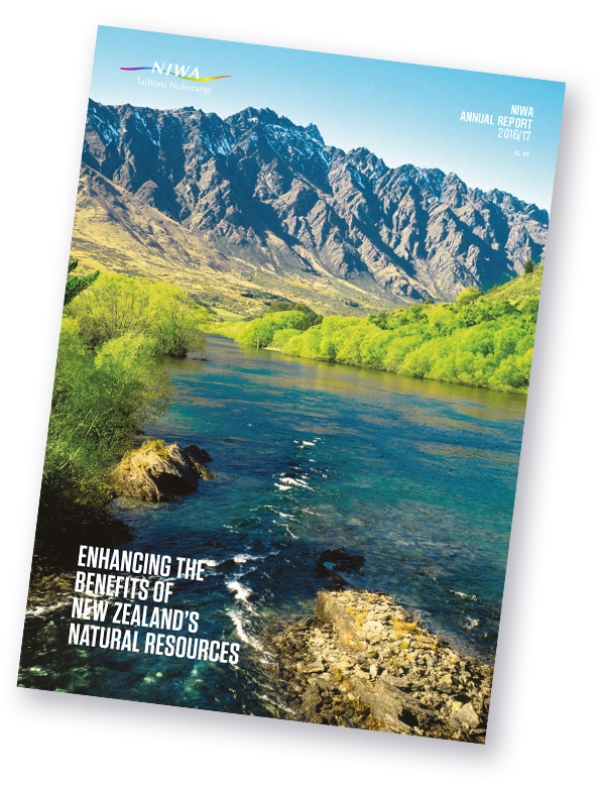Widening concern for the state of our prized freshwater resources, growing recognition of the need to prepare for climate variability and change, a continuing push for sustainable economic growth based on natural resource use, and repeated assaults by nature—hallmarks of a remarkable year in which NIWA’s expertise, leadership and technical capabilities were in constant demand.
Download the NIWA Annual Report 2016/17: part one pp 1-51 [PDF 4.3MB] and NIWA Annual Report 2016/17: part two pp 52-121 [PDF 3.6MB]
We had to step up to the challenge in a manner that befits our status as New Zealand’s pre-eminent provider of atmospheric, freshwater and marine science.
In our 2016/17 Statement of Corporate Intent, we anticipated an intensifying national debate about the current and future state of New Zealand’s freshwater resources. That turned out to be the case. The stakeholder conversation was both prolonged and impassioned, fuelled by the release of the Government’s Clean Water package of proposed reforms, including the contentious ‘swimmable rivers’ aspiration.
Clean and abundant freshwater is the lifeblood of our economy, and a defining feature of our national identity, so it is hardly surprising that emotions ran high. However, policymakers and community leaders recognise the need to remove sentiment from the conversation, and inform their decision-making with impartial scientific evidence to ensure outcomes are acceptable for all stakeholders.
That is where NIWA’s expertise came into play.
Throughout the year, our hydrologists and water-quality researchers were called upon to assess the complex natural and human influences on freshwater quality and availability, at many scales, and for a variety of purposes. We prepared our own analysis of the Government’s Clean Water proposals, and made a key contribution to a seminal report released by Sir Peter Gluckman, the Prime Minister’s Chief Science Advisor, titled ‘New Zealand’s fresh waters: Values, state, trends and human impacts’. This, coupled with our business-as-usual efforts to measure, predict, protect and mitigate, firmly cemented our position at the forefront of independent freshwater science in New Zealand.
We also expected the drive to prepare New Zealand communities for climate variability and change to reach a turning point during the year. Following the release of NIWA’s national climate change projections by the Ministry for the Environment last year, several councils engaged us to prepare outlooks tailored to their regions of responsibility. It is heartening to see that most local authorities now acknowledge the pressing need to incorporate climate change impacts into their economic, infrastructural and environmental planning. NIWA is recognised as New Zealand’s authoritative source of guidance in this field.
What we couldn’t foresee, however, was the way Nature would repeatedly and dramatically test the resilience of New Zealanders during the year.
In the early minutes of 14 November, central New Zealand lurched violently as the largest earthquake to affect the country in over 80 years struck near Kaikōura. Within a few tumultuous minutes, lives and livelihoods—as well as large tracts of land and seafloor—were radically altered.
This event gave us the opportunity to apply our specialist expertise and sophisticated technology—both to inform the Government, the science community and the public generally in the immediate aftermath of the quake, and to acquire knowledge critical to future hazard-management efforts. We rapidly redeployed our flagship research vessel, Tangaroa, to the waters off Kaikōura and began surveying and mapping the upheaval that had taken place beneath. Within a few days, we were able to share valuable insights into changes in the sub-seabed fault structure, the nature and behaviour of the tsunami that followed the quake, and the impacts on marine habitats and resources in the area.
Our agility was similarly tested during subsequent months, when devastating fires swept across Christchurch’s Port Hills, wide swathes of New Zealand were buffeted by the remnants of two tropical cyclones, and the country’s highly valued oyster industry faced a grave threat from Bonamia ostreae. In each case, we quickly diverted expert resources to the task of assessing and analysing the impacts, and informing those involved in managing the response.
Rapid responses to areas of opportunity and need, such as these, characterised the year. This, coupled with significant growth in the scope of core research and applied-science programmes that make up our three research platforms—climate and atmosphere, freshwater, and marine—meant our workload was at an all-time high.
With this additional demand, we had to recruit almost 100 science, technical and support staff during the year, of which about half were new positions. In so doing, we bolstered our ability to deliver outstanding science for the benefit of all New Zealanders—a fact reflected in our very pleasing annual result.
Revenue growth, the resolution of research funding uncertainties in key areas as identified in our 2016/17 Statement of Corporate Intent, and tight control over costs contributed to our very pleasing financial performance.
Revenue was $142.6 million, earnings before interest, tax, depreciation and amortisation (EBITDA) was $20.8 million, and net profit after tax (NPAT) was $4.3 million.
Please refer to the NIWA Annual Report 2016/17 pdf for the complete Chairman & Chief Executive’s review of NIWA’s 2016/17 year.

